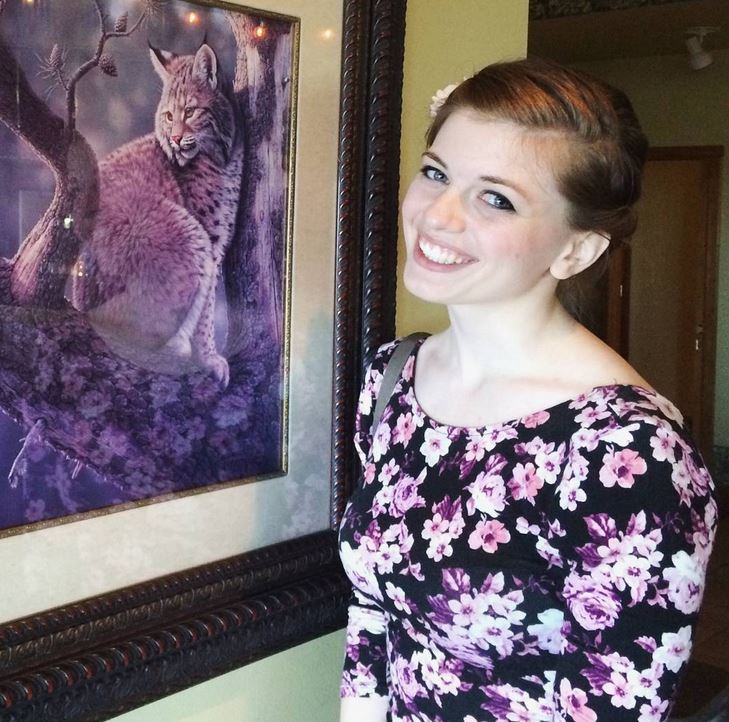Elysia Webb is a graduate student at the University of Florida. In Spring 2017 she contributed to Wikipedia for a course on Principles of Systematic Biology, taught by Emily Sessa. In this post she shares her experience improving the article on the Florida bonneted bat and the editing she has continued to do outside of class, focusing on other bat species and bat-related topics (for example, bat flight, greater long-nosed bat, and Maclaud’s horseshoe bat).
For years, I have been a consumer of Wikipedia. Now, I’m also a contributor.

Image: Elysia Webb headshot.jpg, by Elysia Webb, CC BY-SA 4.0, via Wikimedia Commons.
I didn’t get an introduction into the nuts and bolts of contributing to Wikipedia until my first year of graduate school. All the students in my systematic biology class had to create or drastically alter a page, and the topics were just as diverse as our fields of study: calibrating the molecular clock, obscure genera of flowering plants, and subfamilies of moths are examples of topics we covered. As for me, I wrote about my study species—an endangered New World bat.
The article for my bat already existed, but it was deficient in multiple areas. I took it to my sandbox to flesh it out, using the skills that I had picked up in the training modules. I created a distribution map of my species; I added paragraphs of text. Upon seeing that there were no freely-available images of this bat, which was why the article had no photos, I uploaded my first image to Wikipedia Commons—an image I had snapped with my cell phone, to become the public face of this bat.
I watched as the article grew from a skeleton to a true Wikipedia article, with sections, citations, and images, and I felt pride at knowing that I was the impetus of change. I realized that the page was part of a WikiProject, and their classification of the page changed from “start” class to “B” class, indicative of a vast improvement.
After that first article, I was hooked.
Here I was, a ready-made researcher in training, used to ferreting out information from academic journals, and compiling sources for cohesive proposals or overviews. My academic status allowed me to pass through paywalls into the gated communities of online journals, and pull out citable information. The semester that I signed up for my Wikipedia account, I surpassed a thousand edits. Now that I knew how to edit articles and had the tools to do so, I had no excuse not to.
It’s surprising that the simple act of being assigned a Wikipedia page to edit would be so transformative. It’s made me put a lot of thought about the value of science and scientific writing to everyday people. I strongly value the processes of peer review and publishing papers to share information between scientists, but I now believe that the spread of information should be vertical as well, extending past the scientist stratum. Science needs intermediaries who can translate tough jargon and concepts for anyone to read and understand. Science needs resources like Wikipedia so that the public can have free, accessible information. Wikipedia also needs scientists to hold it to its principles of truth and neutrality.
I have always seen the tremendous value of Wikipedia as a consumer, but it took an assignment via Wiki Education to make me see the value of contributing to Wikipedia. At the end of the semester, the instructor asked for our feedback; this was the first time she had made Wikipedia an assignment, and she wanted to know if we recommended that she did the same for future classes. Unanimously, we did. I’m glad that my instructor had the prescience to create a room of Wikipedia editors, who have cumulatively added almost one hundred thousand words across over two hundred articles to the mainspace in the span of a few months. Knowing how to edit Wikipedia has emboldened us to do so, we all agreed. Not only are we emboldened, though; we also feel charged to correct untruths where we see them, and provide information where it is missing.
I am proud to consider myself a biologist, a researcher, and now, an Editor; the Wikipedia Community gives me hope that the truth will always have defenders, and Wiki Education gives me hope that the number will keep growing.
Image: Florida bonneted bat (Eumops floridanus).jpg, by Elysia Webb, CC BY-SA 4.0, via Wikimedia Commons.
